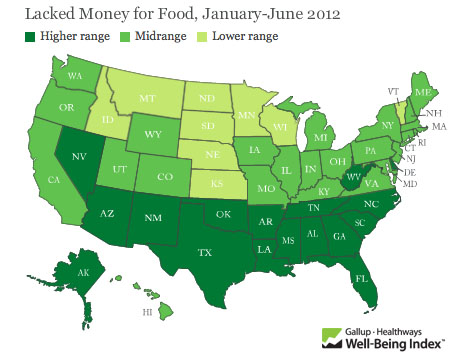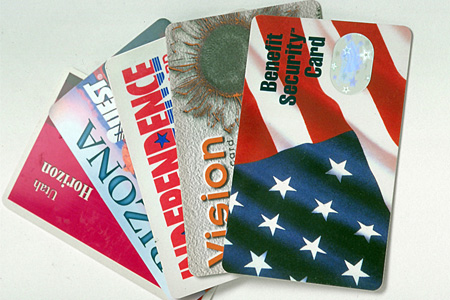
Photo by USDA
But Gallup demonstrates that hunger is everywhere in the U.S. right now. According to the poll, over 18 percent of Americans “say there have been times when they could not afford the food they needed” during the last year. In 15 states, that figure jumps to one in five Americans.
There’s an odd political angle to this poll. The top-10 list for states with the highest hunger rates includes the GOP strongholds of Mississippi, Alabama, Georgia, Arkansas, Oklahoma, Tennessee, West Virginia, and Louisiana. More than half of those states are as red as they come, i.e. even in a landslide these states wouldn’t back Obama.
But here’s the kicker: Gallup mapped the percentage of people who “lacked money for food.” What do you notice?

Red America suffers from the highest hunger rates generally — the exception being the Plains states that have been enjoying, up until recently, an agriculture boom.
A cynic would thus observe the deep irony that Republicans have dubbed Obama the “Food Stamp President,” while the Republican vice presidential nominee Paul Ryan, the party’s acknowledged deep-thinking wonk, wants to cut food stamps by $133 billion over the next decade.
This might be a good time to refer back to this excellent Economist analysis of food-stamp recipients:
It is also hard to argue that food-stamp recipients are undeserving. About half of them are children, and another 8% are elderly. Only 14% of food-stamp households have incomes above the poverty line; 41% have incomes of half that level or less, and 18% have no income at all. The average participating family has only $101 in savings or valuables. Less than a tenth of recipients also receive cash payments from the Temporary Assistance for Needy Families programme (TANF), the reformed version of welfare; roughly a third get at least some income from wages.
The fact that Republicans have utterly abandoned the economic interests of vast swaths of their supporters in favor of whatever it is that Grover Norquist and the Koch brothers want policies that tilt toward the rich doesn’t represent irony as far as I’m concerned. Rather, it’s tragedy.

Photo by Brian Duss.
And as the Gallup analysis makes clear, the ongoing drought will affect food prices for the forseeable future, with the largest impact to be felt in 10 to 12 months. The hardest-hit region will be the South, natch. Too bad the current farm bill, should it ever pass, will cut food stamps starting in 2013 (and will go on to cut $4.5 billion over 10 years).
The feared rise in food prices has encouraged even Republican governors to join their Democratic counterparts in calling on the Environmental Protection Agency (EPA) to relax federal requirements which direct a huge percentage of the now-dwindling corn harvest to ethanol production. For a bit of background, this issue involves the EPA’s Renewal Fuel Standard (RFS) which sets minimum ethanol production levels.
It’s this regulation, not “market forces,” that sends 40 percent of America’s corn harvest into fuel tanks every year, and is a key component of the Great Ethanol Boondoggle. It also seems unwise to enforce the RFS during one of the worst years for corn farmers in recent memory.
But as bad as our ethanol policy is, I would hope that those same GOP governors see this Gallup poll and instead start calling on their congressional colleagues to back off cutting desperately needed food benefits for their own constituents.



